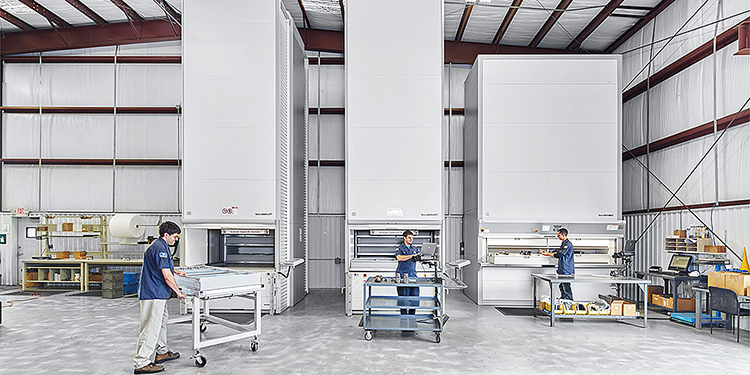Exploring The Differences Between Vertical Lift Modules And Vertical Carousels

Vertical lift modules (VLMs) and vertical carousels are both computer-controlled, automated storage and retrieval systems (ASRS) that maximize cubic footprint by storing items vertically. Their internal components include trays (also called pans, shelves, or carriers) that are moved up and down to store items. Further, both systems improve a picker’s ergonomics by presenting items at waist height — eliminating the need to stretch, bend, or reach to retrieve items. Although both deliver dense inventory storage in manufacturing and warehousing applications, they each function in different ways and solve different material handling challenges. In fact, both machines might be used in the same facility to meet different storage needs. Here, an exploration of the differences between these two ASRS technologies.
Vertical Lift Modules (VLMs) consist of two columns of storage trays accessed by an automatic inserter/extractor positioned between the columns. The machine includes an internal scanner that detects the height of the tallest item in the tray, then dynamically stores it as closely as possible to another tray to minimize wasted space and maximize storage density. This enables VLMs to reach heights of nearly 80 feet. VLMs can hold larger parts and components with capacities up to 2,000 pounds per tray, and typically feature trays that measure 3 feet deep and up to 12 feet wide.
To accommodate bigger items their access openings are generally larger than those of vertical carousels, and they can be equipped with lift assist devices to help with placement and removal of heavier loads from the machine. Each tray can be sub-divided to accommodate multiple, different parts or items. Additionally, because the inserter/extractor interfaces directly with the required tray, a VLM can typically present a tray to an operator in less time than a vertical carousel, which may have to spin past multiple trays to present the next one required.
Vertical Carousels incorporate a series of fixed shelves that rotate vertically, like a Ferris wheel. They are frequently used for storage of fast-moving, small items, such as tooling, components or raw materials. Generally offering capacities ranging from 330 pounds to 1,500 pounds per shelf, each shelf can be sub-divided to accommodate a variety of different parts or items. Vertical carousels tend to be shorter than VLMs — reaching heights around 35 feet — in order to minimize the number of shelves that may need to be cycled through between picks. Further, their shelves typically measure 2 feet deep and up to 12 feet wide.
When working with an ASRS supplier to determine which technology is optimal for a given application, provide the following inventory details:
- Dimensions of each item to be stored (length, width, height)
- Weight of each item to be stored, either individually (an engine block, for example) or as a bulk unit (such as a bag of 100 washers)
- Number of items to be stored in the unit
- The footprint of the location where the unit is to be installed
It may also be helpful to share example products with the VLM or vertical carousel supplier. They can offer guidance to help with the internal layout and sub-division of each tray to ensure that all available storage space is maximized. Depending on item profiles and storage density needs, multiples of one (or both) type(s) of ASRS might be implemented within the same facility.
Additionally, storing vertically adjusts picking workflows to adhere to the CDC’s social distancing guidelines, and greatly reduces the chances of employees crossing paths at multiple points within a warehouse. Pickers can remain in the safety of their posts, and — when several machines are in use — measures such as plexiglass partitions can be enacted for additional security.
Finally, with proper preventive maintenance and routine service, both VLMs and vertical carousels will provide long, reliable operation for decades.
Want to learn more about the other types of ASRS solutions available? Watch this series of videos produced by the Automated Storage and Retrieval Systems Industry Group of MHI.



